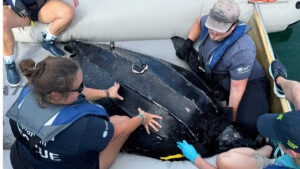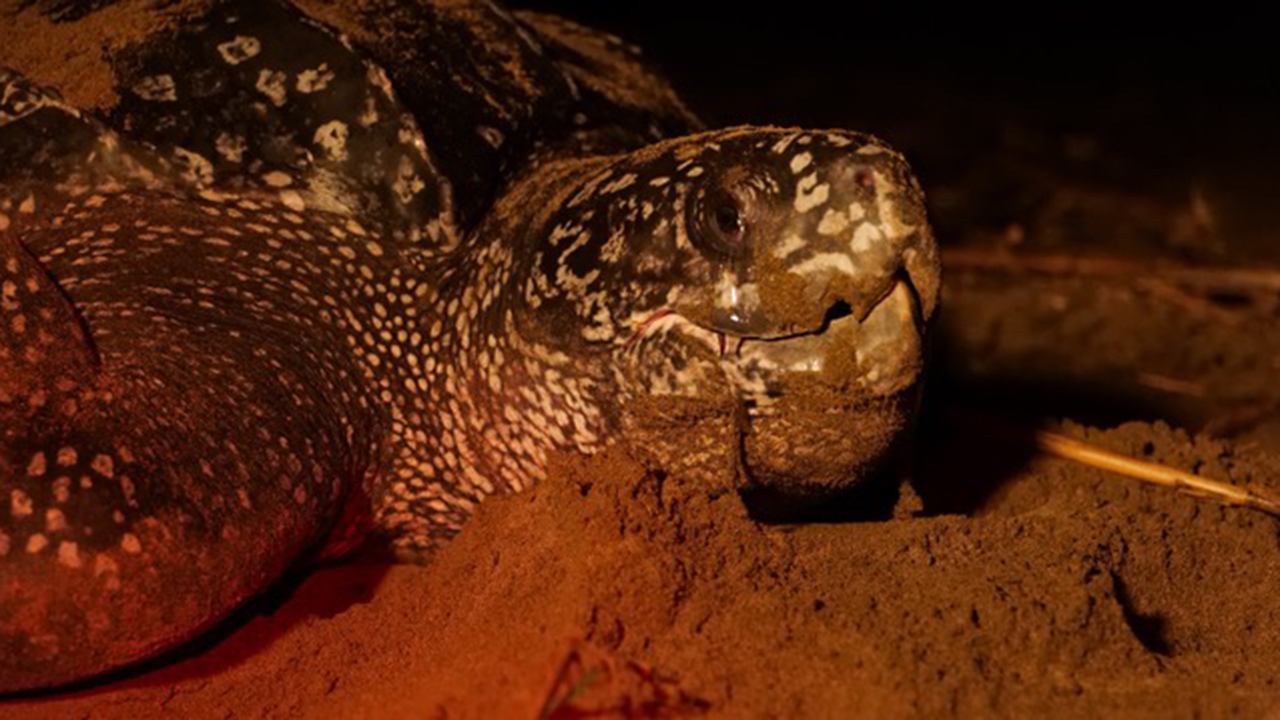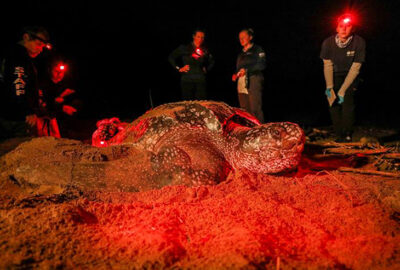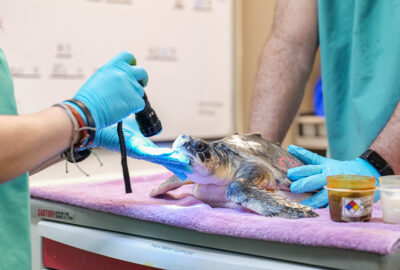Please Note: Our Box Office is currently closed for renovation. We recommend purchasing tickets online in advance to expedite your entry into the Aquarium. Tickets can also be purchased onsite at the Information Desk in the lobby today.
Catching Up With Some of Our Longest-Tracked Sea Turtles
Phinney, Marshmallow, and Kida’s ocean adventures are showing Aquarium scientists how sea turtles travel, recover, and thrive across the Atlantic.
By New England Aquarium on Friday, November 21, 2025


When a sea turtle leaves our care after rehabilitation or disentanglement—or swims away from the nesting beaches our team studies—it’s often just the beginning of the story. Scientists at the New England Aquarium’s Anderson Cabot Center for Ocean Life use several kinds of high-tech tracking tags to follow these ocean travelers. Satellite tags, attached to the top of the turtle’s shell, send signals to orbiting satellites each time the animal surfaces, revealing where they go and how they use their habitat. Acoustic tags, attached to the shell or surgically implanted, a method Aquarium scientists pioneered for use with rehabilitated loggerhead turtles, emit unique “pings” that underwater receivers can detect for years—like an ocean-based E-ZPass system.
Together, these technologies let researchers follow turtles across thousands of miles and even years, uncovering new insights into survival, migration, and habitat use. Plus, it’s always nice keeping tabs on old friends!
Here’s what three of our longest satellite-tracked turtles—Phinney, Marshmallow, and Kida—have been up to lately.

Phinney: A leatherback comeback
In July 2024, this six-foot, 400+ pound leatherback sea turtle found himself in trouble in Cape Cod Bay. Entangled in fishing gear, the turtle—later named Phinney by Barnstable Harbormaster responders—was quickly freed thanks to a team effort by the New England Aquarium, Center for Coastal Studies, and Barnstable Harbormaster.
A rope was wrapped around the shoulder area of Phinney’s right front flipper. After a full health assessment confirmed his strength, Aquarium scientists released him back into the ocean with satellite and acoustic tags to monitor his recovery and movement after his disentanglement.

Over the following 14 months, Phinney proved just how resilient leatherbacks can be. The turtle’s tags revealed adventures on the high seas spanning more than 8,000 miles, including dives deeper than 4,000 feet and over 150 detections on acoustic receivers from Canada to Florida. Each transmission offered valuable insight into how these turtles recover and migrate after entanglement.
Leatherbacks in the Northwest Atlantic are listed as Endangered on the International Union for Conservation of Nature Red List, and incidental capture in fishing gear is their leading threat worldwide. Phinney’s story shows that with quick response, collaboration, and ongoing research, second chances are possible for these ocean giants.

Marshmallow: A story of rehabilitation and research
When Marshmallow, a 100-pound loggerhead, washed ashore during the 2023 cold-stun season, their journey to recovery began at the New England Aquarium’s Sea Turtle Hospital. Each year, hundreds of sea turtles are brought to the Sea Turtle Hospital after getting stuck in rapidly cooling waters around Cape Cod, a growing threat linked to climate change.
After months of care and rehabilitation, Marshmallow was released off Dennis, Massachusetts in August 2024, joining a group of 31 recovered turtles returning to the wild during the Aquarium’s summer release season. Loggerheads are a globally Vulnerable species, so each successful release is a meaningful step in helping the population rebound. Before release, scientists fitted Marshmallow with satellite and acoustic tags to learn how rehabilitated turtles adjust once they’re back at sea.
Over the next year or so, Marshmallow’s travels painted a hopeful picture. Marshmallow spent several months feeding in Nantucket Sound, then migrated south to the warmer waters of North Carolina before returning north this past summer to Nantucket Sound to enjoy our region’s abundance of crabs and shellfish.
Tracking turtles like Marshmallow helps scientists measure the long-term success of rehabilitation and reintegration into the wild, and deepens our understanding of how endangered and threatened sea turtles adapt in a changing ocean.

Kida: Mapping a leatherback’s epic journey
Kida has been making waves since 2016, when her first nest was recorded in Dorado, Puerto Rico by scientists with the organization Chelonia. Loyal to the same beach, she regularly nests at Playa Grande El Paraíso. When she returned to nest once again in the spring and summer of 2024, she was fitted with a satellite tag by Aquarium scientists while she laid her eggs on the beach. Tag data revealed that she laid at least seven nests between March and June before beginning a long migration north toward Newfoundland, Canada. Over the past year and a half, she has traveled more than 16,000 miles, spending time in Atlantic Canada, the southeast US, and offshore in Gulf Stream waters, swimming an average of 30 miles a day.
Kida’s journey is part of a collaborative tagging and research initiative led by our Anderson Cabot Center for Ocean Life scientist Dr. Kara Dodge and community-based partners across Puerto Rico. Using satellite telemetry, researchers are studying where leatherbacks nest, how often they return, and how they use vital foraging and migratory habitats.
Leatherback nesting populations in the North Atlantic are in decline, making this work essential to understanding and protecting the species. Data from turtles like Kida help scientists identify critical habitats, strengthen international conservation efforts, and support the next generation of ocean stewards.
Kida’s tag is still transmitting her location today. It appears she may be heading back to Puerto Rico to nest again in 2026, where our team will be waiting to welcome her “home”!
Follow Kida’s journey on our Sea Turtle Tracker.
See where Phinney, Kida, and Marshmallow traveled

Why long-term tracking matters
Each of these turtles offers a unique window into how sea turtles recover, migrate, and survive in a changing ocean. By following their movements over months and years, researchers can pinpoint important habitats, track the success of rescue and rehabilitation efforts, and strengthen global conservation strategies for these at-risk sea turtle species.
The next time you visit the Aquarium, you might spot green sea turtle Myrtle and loggerheads Carolina and Retread in the Giant Ocean Tank exhibit. But beyond our walls, there are many sea turtles like Phinney, Marshmallow, and Kida who are part of the Aquarium, helping our scientists uncover new stories about life in the ocean and how we can protect it.




